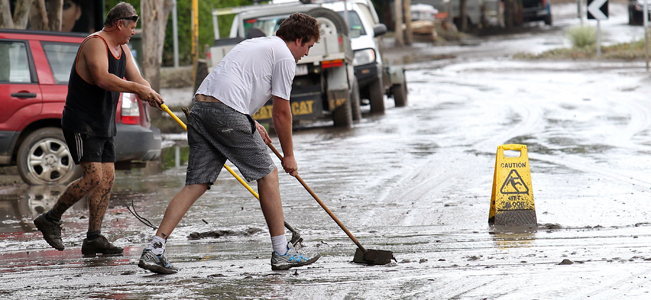CASPER
THE FRIENDLY GHOST

In the early hours of Jan. 12, Paul Pisasale, the mayor of Ipswich, saw the Bremer River swallow 43 streets, flush out 1,100 residents and inundate 3,000 homes. Refrigerators, soggy mattresses and children's toys all became flotsam on the watery streets of the small town west of Brisbane, Australia, while evacuees waited for the waters to recede.
Throughout the past week, Ipswich residents have gradually returned to their drenched possessions and sludge-filled homes. An army of volunteers, including sports stars and politicians, have helped with the cleanup and attempted to lift spirits. Even celebrity chef Jamie Oliver offered free meals to the devastated town. "I have seen people whose homes have been flooded help clear up the homes of their neighbors," says Pisasale. "I have heard people who have had their livelihoods washed away on the streets saying, 'I lost everything, but there are other people worse off than me.' " (See pictures of the flooding in Australia.)
As roads have reopened, the state of Queensland has started to recover from its worst floods in decades, a process that will take years and cost billions of dollars. According to the Australian, the death toll stands at 33, but that number will creep up. Ten people have been missing for the past week, and hopes for their safe return are slim. As floods are now sweeping through Australia's southeastern state of Victoria, the people of Queensland are beginning to ask if this disaster was avoidable.
On Jan. 17, Queensland's premier, Anna Bligh, launched a yearlong commission of inquiry into the floods to determine what measures could have been taken to prevent them or lessen their impact. It will examine all aspects of the disaster, from the adequacy of weather warnings to the effectiveness of the emergency services. "The last three weeks have been truly shocking for all Queenslanders, and now is the time to forensically examine the devastating chain of events and the aftermath," Bligh said in a statement. (See more about the flooding's destruction in Brisbane.)
A key subject of the investigation will be the adequacy of the Wivenhoe Dam, which was built as a response to the Brisbane floods of 1974. The dam swelled to 191% capacity before workers released water from it. According to experts, it was not far from blowing its fuse-wall plugs. "I want to know why the dam was allowed to get so full," says Andrew Dragun, an adjunct professor of economics at Queensland's Australian Rivers Institute of Griffith University. If the dam's operators were aware of the weather predictions, he asks, why wasn't more water released?
South East Queensland (SEQ) Water Grid, the public utility that oversees the dam, has been tight-lipped on its emergency strategy. A spokeswoman from SEQ Water Grid told Fairfax Media that its strategy was not "a publicly available document, and is owned and operated by SEQ Water Grid." Dragun and others disapprove of this secrecy, given the fact that more rain is expected to be on the way. "We need to know what's going on," he says. "We have a wet few months ahead of us."
